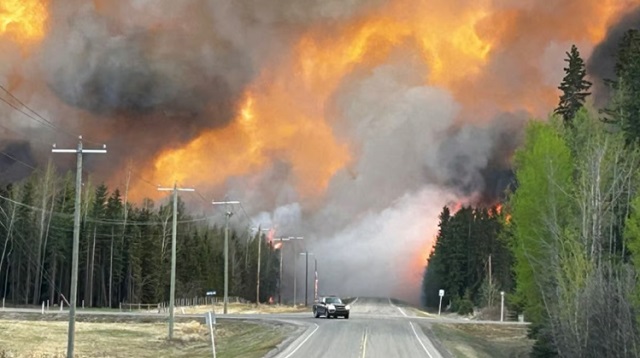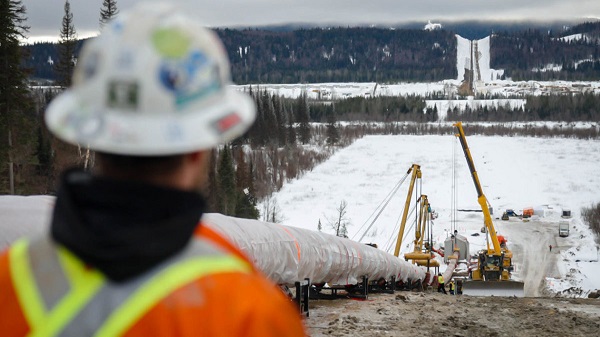Alberta
Thank the beetle and deadwood ‘fuel’ that should have been cleared

By Josh Andrus
Originally posted in the Western Standard
Parks Canada officials admit they failed to conduct controlled burns of dead pine trees, which now pose a significant fire risk.
While Ottawa fixates on climate change rhetoric, their neglect of forest fire prevention has left Alberta’s landscapes vulnerable to devastation.
Last week, a shining beacon of the beauty of our province was partially destroyed as a wildfire burned through the picturesque town of Jasper. Our thoughts and prayers go out to the victims.
Thankfully there has been no reported loss of life. But many people’s livelihoods have been wiped out. The question is how did this happen, and what could have been done to prevent it?
Smokey Bear’s famous saying was: “Only you can prevent forest fires.” And, in this case, proactive measures certainly could have made a difference.
Unfortunately, the entire federal government seems to have forgotten Smokey’s key point. Fire prevention on national park land is federal jurisdiction.
In 2022, Environment Minister Steven Guilbeault was informed that Parks Canada managers had not taken adequate precautions to protect the Town of Jasper from wildfires, according to documents obtained by Blacklock’s Reporter. At that time, Parks Canada officials admitted they had failed to conduct controlled burns of dead pine trees, which posed a significant fire risk.
“A mountain pine beetle infestation has brought significant changes to forests in Alberta, including Jasper National Park, with consequences for wildfire risk,” Guilbeault was informed.
Almost half of Jasper’s Whitebark Pine forest, 44%, was infected by beetles. However, few steps were taken to reduce the risk to the Town of Jasper with controlled burns of the surrounding forest, records show.
“Fire has not yet been applied for Whitebark Pine restoration,” stated a 2022 implementation report. “Mechanical thinning has been completed in 1.6 hectares, which is a small area relative to the amount of Whitebark Pine habitat.”
No reason was given for failing to take precautions. Since the fire, Guilbeault has made no public mention of the management reports.
Even though federal officials, including his department, knew the raging pine beetle was a serious hazard, Guilbeault blamed climate change: “As we are seeing in Canada and all around the world, we are seeing more and more aggressive forest fires,” he said on a media call on Monday.
Landon Shepherd, Incident Commander for Parks Canada, also attributed the intensity of the blazes to climate change: “This isn’t meant to be a discussion about climate change, but anyone who’s involved in fire management can tell you that things have become more difficult, especially in the last five years, to manage impacts.”
The 2022 warnings were not the first time concerns about a lack of fire prevention in national parks have been raised.
In 2018, CBC reported concerns from experts. Emile Begin and Ken Hodges, foresters for 40 years who had been studying Jasper National Park, found multiple issues with the forest that make it susceptible to a fire.
“You have fire suppression that has occurred for many years — therefore, you get a lot of dead fuel that would have been consumed by a natural process,” Hodges said. “The mountain pine beetle adds even more fuel to the situation.”
“You’ve got a major catastrophe on your hands if you get a match thrown into that.”
When pressed about the concerns, Alan Fehr, a superintendent for Jasper National Park, said: “We’re quite comfortable with where we are with our own emergency planning and evacuation planning.”
Hodges disagreed: “The potential that’s out there is actually scary. Hopefully, we’re wrong.”
Despite the repeated warnings of potential devastation due to forest management practices, Ottawa continues to point to climate change as the cause of the fires.
The Alberta government has been preparing, and increased its firefighting budget by more than 50% to $155.4 million this year. Alberta’s firefighting budget is now the highest it has ever been (despite misinformation about cuts.)
However, without proper fire prevention on national park land, blazes can become out of control quickly — as the warnings indicated.
Smokey Bear would be horrified. Clearly, Ottawa needs to spend less time interfering in provincial jurisdiction and more time focusing on things that actually are federal jurisdiction, like fire prevention in national parks.
Their inability to see the forest through the trees and take legitimate action to protect our national parks from the fury of an out-of-control wildfire demonstrates a degree of ineptitude that is, quite frankly, shocking.
Ottawa needs to stay in its lane and focus on its own jurisdiction, and they need to stop blaming climate change for their own ineptitude.
Alberta
Energy sector will fuel Alberta economy and Canada’s exports for many years to come

From the Fraser Institute
By any measure, Alberta is an energy powerhouse—within Canada, but also on a global scale. In 2023, it produced 85 per cent of Canada’s oil and three-fifths of the country’s natural gas. Most of Canada’s oil reserves are in Alberta, along with a majority of natural gas reserves. Alberta is the beating heart of the Canadian energy economy. And energy, in turn, accounts for one-quarter of Canada’s international exports.
Consider some key facts about the province’s energy landscape, as noted in the Alberta Energy Regulator’s (AER) 2023 annual report. Oil and natural gas production continued to rise (on a volume basis) in 2023, on the heels of steady increases over the preceding half decade. However, the dollar value of Alberta’s oil and gas production fell in 2023, as the surging prices recorded in 2022 following Russia’s invasion of Ukraine retreated. Capital spending in the province’s energy sector reached $30 billion in 2023, making it the leading driver of private-sector investment. And completion of the Trans Mountain pipeline expansion project has opened new offshore export avenues for Canada’s oil industry and should boost Alberta’s energy production and exports going forward.
In a world striving to address climate change, Alberta’s hydrocarbon-heavy energy sector faces challenges. At some point, the world may start to consume less oil and, later, less natural gas (in absolute terms). But such “peak” consumption hasn’t arrived yet, nor does it appear imminent. While the demand for certain refined petroleum products is trending down in some advanced economies, particularly in Europe, we should take a broader global perspective when assessing energy demand and supply trends.
Looking at the worldwide picture, Goldman Sachs’ 2024 global energy forecast predicts that “oil usage will increase through 2034” thanks to strong demand in emerging markets and growing production of petrochemicals that depend on oil as the principal feedstock. Global demand for natural gas (including LNG) will also continue to increase, particularly since natural gas is the least carbon-intensive fossil fuel and more of it is being traded in the form of liquefied natural gas (LNG).
Against this backdrop, there are reasons to be optimistic about the prospects for Alberta’s energy sector, particularly if the federal government dials back some of the economically destructive energy and climate policies adopted by the last government. According to the AER’s “base case” forecast, overall energy output will expand over the next 10 years. Oilsands output is projected to grow modestly; natural gas production will also rise, in part due to greater demand for Alberta’s upstream gas from LNG operators in British Columbia.
The AER’s forecast also points to a positive trajectory for capital spending across the province’s energy sector. The agency sees annual investment rising from almost $30 billion to $40 billion by 2033. Most of this takes place in the oil and gas industry, but “emerging” energy resources and projects aimed at climate mitigation are expected to represent a bigger slice of energy-related capital spending going forward.
Like many other oil and gas producing jurisdictions, Alberta must navigate the bumpy journey to a lower-carbon future. But the world is set to remain dependent on fossil fuels for decades to come. This suggests the energy sector will continue to underpin not only the Alberta economy but also Canada’s export portfolio for the foreseeable future.
Alberta
The beauty of economic corridors: Inside Alberta’s work to link products with new markets

From the Canadian Energy Centre
Q&A with Devin Dreeshen, Minister of Transport and Economic Corridors
CEC: How have recent developments impacted Alberta’s ability to expand trade routes and access new markets for energy and natural resources?
Dreeshen: With the U.S. trade dispute going on right now, it’s great to see that other provinces and the federal government are taking an interest in our east, west and northern trade routes, something that we in Alberta have been advocating for a long time.
We signed agreements with Saskatchewan and Manitoba to have an economic corridor to stretch across the prairies, as well as a recent agreement with the Northwest Territories to go north. With the leadership of Premier Danielle Smith, she’s been working on a BC, prairie and three northern territories economic corridor agreement with pretty much the entire western and northern block of Canada.
There has been a tremendous amount of work trying to get Alberta products to market and to make sure we can build big projects in Canada again.
CEC: Which infrastructure projects, whether pipeline, rail or port expansions, do you see as the most viable for improving Alberta’s global market access?
Dreeshen: We look at everything. Obviously, pipelines are the safest way to transport oil and gas, but also rail is part of the mix of getting over four million barrels per day to markets around the world.
The beauty of economic corridors is that it’s a swath of land that can have any type of utility in it, whether it be a roadway, railway, pipeline or a utility line. When you have all the environmental permits that are approved in a timely manner, and you have that designated swath of land, it politically de-risks any type of project.
CEC: A key focus of your ministry has been expanding trade corridors, including an agreement with Saskatchewan and Manitoba to explore access to Hudson’s Bay. Is there any interest from industry in developing this corridor further?
Dreeshen: There’s been lots of talk [about] Hudson Bay, a trade corridor with rail and port access. We’ve seen some improvements to go to Churchill, but also an interest in the Nelson River.
We’re starting to see more confidence in the private sector and industry wanting to build these projects. It’s great that governments can get together and work on a common goal to build things here in Canada.
CEC: What is your vision for Alberta’s future as a leader in global trade, and how do economic corridors fit into that strategy?
Dreeshen: Premier Smith has talked about C-69 being repealed by the federal government [and] the reversal of the West Coast tanker ban, which targets Alberta energy going west out of the Pacific.
There’s a lot of work that needs to be done on the federal side. Alberta has been doing a lot of the heavy lifting when it comes to economic corridors.
We’ve asked the federal government if they could develop an economic corridor agency. We want to make sure that the federal government can come to the table, work with provinces [and] work with First Nations across this country to make sure that we can see these projects being built again here in Canada.
-

 2025 Federal Election2 days ago
2025 Federal Election2 days agoLondon-Based Human Rights Group Urges RCMP to Investigate Liberal MP for Possible Counselling of Kidnapping
-

 2025 Federal Election1 day ago
2025 Federal Election1 day agoPM Carney’s Candidate Paul Chiang Steps Down After RCMP Confirms Probe Into “Bounty” Comments
-

 International17 hours ago
International17 hours agoTrump’s ‘Golden Dome’ defense shield must be built now, Lt. Gen. warns
-

 2025 Federal Election2 days ago
2025 Federal Election2 days agoBeijing’s Echo Chamber in Parliament: Part 2 – Still No Action from Carney
-

 2025 Federal Election2 days ago
2025 Federal Election2 days agoRCMP Confirms It Is ‘Looking Into’ Alleged Foreign Threat Following Liberal Candidate Paul Chiang Comments
-

 2025 Federal Election1 day ago
2025 Federal Election1 day agoFight against carbon taxes not over yet
-

 Business20 hours ago
Business20 hours agoSaskatchewan becomes first Canadian province to fully eliminate carbon tax
-

 2025 Federal Election22 hours ago
2025 Federal Election22 hours agoMark Carney refuses to clarify 2022 remarks accusing the Freedom Convoy of ‘sedition’







